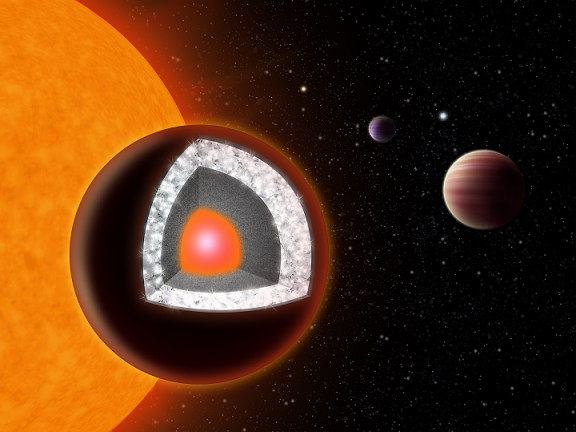Discovery Of Diamond Planet Opens A New Rocky World

A U.S.-French research team has reported the discovery of a planet, named as '55 Cancri e', which is largely made out of diamond and is 40 light years away from earth.
The findings of the study conducted by Nikku Madhusudhan, a postdoctoral researcher in physics and astronomy at Yale University, and Olivier Mousis from the Institut de Recherche en Astrophysique et Planetologie in Toulouse, France, will be published in the Astrophysical Journal Letters.
In an exclusive interview with International Business Times, Madhusudhan said that the carbon rich planet is expected to be covered with graphite and diamond.
Here are excerpts of the interview:
The diamond planet is found to be different from the planets in the solar system. What makes it different? Do you have details on how it evolved?
It is different because rocky planets in the solar system, such as Earth, are composed mostly of oxygen-rich compounds such as silicates, whereas carbon is very rare (less than 0.1 percent). On the other hand 55 Cancri e can have a substantial amount carbon, even 30 percent or more. The difference in composition can lead to different geochemical and geophysical processes than what we see on solar system planets.
How did you come to the conclusion that this planet, called 55 Cancri e, has its surface covered with diamond?
Based on our study, the planet 55 Cancri e is expected to be dominated by pure carbon in its outer layers. And, the most stable forms of pure carbon under high pressures of planetary interiors are graphite and diamond. So, it is expected that the surface of the planet is likely covered in graphite and diamond.
How relevant is the discovery of the diamond planet to the world of astrophysics?
It fundamentally changes our perspective on what planets around other stars could be like. The study basically indicates that we can no longer assume rocky planets elsewhere to be Earth-like, i.e. composed of oxygen-rich mineral and rocks and abundant in water and oxygen.
Could you elaborate on further plans as part of follow-up observations to better understand 55 Cancri e?
There are two types of follow-up observations that will help. Firstly, we need to see if the planet has an atmosphere, and if so, what its composition is. Carbon-rich molecules in the atmosphere will be a strong indication of a carbon-rich interior. Secondly, we want to measure the star chemical composition more accurately to confirm the star is also indeed carbon-rich. A carbon-rich star indicates that the planet formed in a carbon-rich environment just like its star, and hence it's carbon-rich interior composition becomes more plausible.
Do you foresee that humans could visit this planet in the near future?
Humans will not be able to visit the planet in any near future because the planet is 40 light years away, i.e. even if one travels at the speed of light, it would take 40 years. But, we are nowhere close to that speed right now.
Is this diamond planet visible to the naked eye from our earth?
No, the planet itself is not visible. But, the star which the planet orbits is visible to the naked eye in the constellation of cancer.
© Copyright IBTimes 2024. All rights reserved.





















